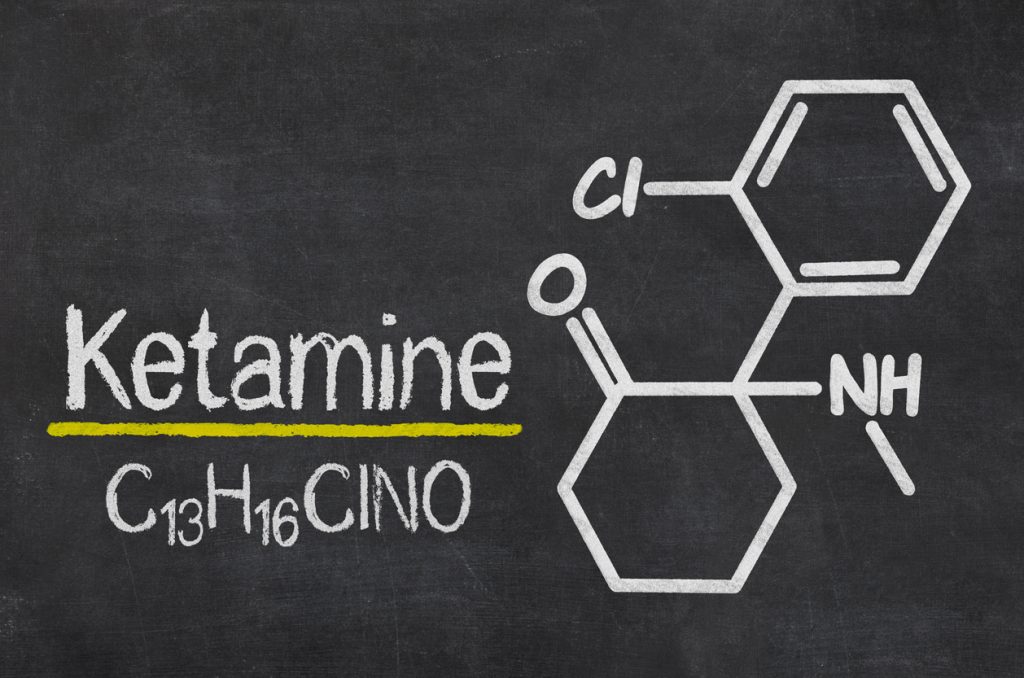Who is Actively abusing Ketamine?
As previously discussed in part II, Ketamine became dominant in the recreational drug scene in the 1980s. The rave and nightclub subcultures had a prodigious appetite for the substance as it often heightened the effects of MDMA (ecstasy). Recreational use continued to spread, despite the Schedule III classification in 1999. Today, Ketamine still remains a party drug and is most frequently used by high school students and young adults to achieve a dream-like, hallucination state.

Blackboard with the chemical formula of Ketamine
According to findings from the National Survey on Drug Use and Health, the highest rate of usage is 0.2% for those aged 18-25, and 0.1% for anyone 12 and older. The drug is fast acting, even more so when injected or snorted, and the intense effects will last for up to an hour or so. Many see it as the ideal, “quick party high” that doesn’t keep the user out of commission for an extended period of time. Ketamine also has a high abuse potential for those attempting to self-medicate feelings of suicidal ideation or depression, since it has the ability to mask these symptoms pretty swiftly.
Psychiatrists are continually studying the potential efficacy of Ketamine to be used as a remedy for deep depression and fleeting thoughts of suicide. A patient may enter a medical setting with these symptoms and could get quick release from a controlled dose. When the person is void of their symptoms, the psychiatrist(s) could then develop an outpatient program of therapy, long-term medication plans and other planned treatments. This culmination of theories has given rise to Ketamine clinics across the US. However, the treatment has not been tested enough, and the potential for addiction will always be a concern.
An Addiction to Ketamine
Ketamine addiction is difficult to overcome if you do not receive the proper help. Even if someone is making a concerted effort to quit their habit, the chemical changes in the brain make it nearly impossible without proper medical intervention. When a person reaches the addicted state, they go about their days feeling almost completely detached, incapable of leading a life that is normal and productive. At this stage, they are often cognitively impaired, with speech and memory both suffering.
Some of the most apparent signs of Ketamine addiction can include:
- Increasing dosage over time
- Becoming obsessed over next usage
- Spending large sums of money on the drug
- Unable to keep up with work, school, or familial obligations
- Building up a tolerance and needing more to satiate your high
- Neglecting relationships with family and friends
- Bladder pain
- Incontinence
- Insomnia
- Loss of coordination
The Comedown from Ketamine
Regardless of if Ketamine was used for a short period of time or not, there is a high chance that the user could experience something known as the “comedown”. This occurrence is similar to a hangover and can be very dangerous to deal with. Because Ketamine is designed as a sedative, it’s common for users to deal with bouts of confusion and delirium when the initial effects of the high begin to wane. Individuals could deal with muscle weakness, anxiety, and increased feelings of hopelessness and helplessness. Impaired vision, severe confusion, aggressive behavior, amnesia, and delirium are also common. The aforementioned symptoms are more likely to occur when taking higher doses of Ketamine, often repeated over several hours, or when combining Ketamine with other substances.
Common Drug Combinations
When Ketamine is paired with other drugs, it can certainly exacerbate the already deadly side effects. Ketamine in liquid form can be mixed into alcoholic beverages or added to Marijuana joints. Ketamine mixed with alcohol and other depressants is undeniably dangerous as Ketamine is itself a depressant. Ketamine mixed with MDMA is also a dangerous pair. MDMA is a stimulant and Ketamine is a depressant, the opposing effects of both drugs are anything but harmonious, and intense side effects can come about.
Seeking Treatment for Ketamine Addiction?
Ketamine, just like any other illicit substance, has the potential to lead to tolerance and addiction. Once an addiction happens and this individual is using drugs a majority of the time, it becomes easy to spot the signs since its psychological effects are so intense. All addictions are identified by cravings, fixation on the drug, neglecting responsibilities, and ignoring family and friends, because you are all in on sustaining your Ketamine addiction. One may attempt to quit on their own, but the physical and emotional hurdles make it much more taxing. Thankfully, our team with Maryland Addiction Recovery Center have you covered with evidence-based care that tackles every stage of addiction.
If you or someone you know needs help for addiction or co-occurring disorder issues, please give us a call. Maryland Addiction Recovery Center offers the most comprehensive dual diagnosis addiction treatment in the Mid-Atlantic area. If we aren’t the best fit for you or your loved one, we will take the necessary time to work with you to find a treatment center or provider that better fits your needs. Please give us a call at (866) 925-5116 or email our team at info@marylandaddictionrecovery.com. For more information on all of our drug addiction, alcohol addiction and co-occurring disorder services and recovery resources, please visit our website at www.marylandaddictionrecovery.com.